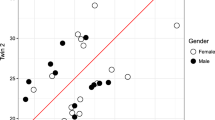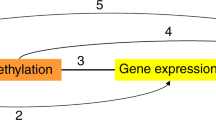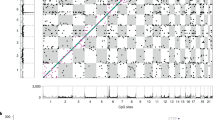Abstract
Background/Objectives:
The relationship between obesity and chronic disease risk is well-established; the underlying biological mechanisms driving this risk increase may include obesity-related epigenetic modifications. To explore this hypothesis, we conducted a genome-wide analysis of DNA methylation and body mass index (BMI) using data from a subset of women in the Sister Study.
Subjects/Methods:
The Sister Study is a cohort of 50 884 US women who had a sister with breast cancer but were free of breast cancer themselves at enrollment. Study participants completed examinations which included measurements of height and weight, and provided blood samples. Blood DNA methylation data generated with the Illumina Infinium HumanMethylation27 BeadChip array covering 27,589 CpG sites was available for 871 women from a prior study of breast cancer and DNA methylation. To identify differentially methylated CpG sites associated with BMI, we analyzed this methylation data using robust linear regression with adjustment for age and case status. For those CpGs passing the false discovery rate significance level, we examined the association in a replication set comprised of a non-overlapping group of 187 women from the Sister Study who had DNA methylation data generated using the Infinium HumanMethylation450 BeadChip array. Analysis of this expanded 450 K array identified additional BMI-associated sites which were investigated with targeted pyrosequencing.
Results:
Four CpG sites reached genome-wide significance (false discovery rate (FDR) q<0.05) in the discovery set and associations for all four were significant at strict Bonferroni correction in the replication set. An additional 23 sites passed FDR in the replication set and five were replicated by pyrosequencing in the discovery set. Several of the genes identified including ANGPT4, RORC, SOCS3, FSD2, XYLT1, ABCG1, STK39, ASB2 and CRHR2 have been linked to obesity and obesity-related chronic diseases.
Conclusions:
Our findings support the hypothesis that obesity-related epigenetic differences are detectable in blood and may be related to risk of chronic disease.
This is a preview of subscription content, access via your institution
Access options
Subscribe to this journal
Receive 12 print issues and online access
$259.00 per year
only $21.58 per issue
Buy this article
- Purchase on Springer Link
- Instant access to full article PDF
Prices may be subject to local taxes which are calculated during checkout
Similar content being viewed by others
References
Bouchard C, Tremblay A . Genetic influences on the response of body fat and fat distribution to positive and negative energy balances in human identical twins. J Nutr 1997; 127: 943S–947S.
Albuquerque D, Stice E, Rodriguez-Lopez R, Manco L, Nobrega C . Current review of genetics of human obesity: from molecular mechanisms to an evolutionary perspective. Mol Genet Genomics 2015; 290: 1191–1221.
Hemani G, Yang J, Vinkhuyzen A, Powell JE, Willemsen G, Hottenga JJ et al. Inference of the genetic architecture underlying BMI and height with the use of 20,240 sibling pairs. Am J Hum Genet 2013; 93: 865–875.
Arabshahi S, Ibiebele TI, Hughes MC, Lahmann PH, Williams GM, van der Pols JC . Dietary patterns and weight change: 15-year longitudinal study in Australian adults. Eur J Nutr 2016. e-pub ahead of print 26 February 2016.
Martinez JA, Milagro FI, Claycombe KJ, Schalinske KL . Epigenetics in adipose tissue, obesity, weight loss, and diabetes. Adv Nutr 2014; 5: 71–81.
Garcia-Jimenez C, Gutierrez-Salmeron M, Chocarro-Calvo A, Garcia-Martinez JM, Castano A, De la Vieja A . From obesity to diabetes and cancer: epidemiological links and role of therapies. Br J Cancer 2016; 114: 716–722.
Pietilainen KH, Ismail K, Jarvinen E, Heinonen S, Tummers M, Bollepalli S et al. DNA methylation and gene expression patterns in adipose tissue differ significantly within young adult monozygotic BMI-discordant twin pairs. Int J Obes (Lond) 2015; 40: 654–661.
Arner P, Sinha I, Thorell A, Ryden M, Dahlman-Wright K, Dahlman I . The epigenetic signature of subcutaneous fat cells is linked to altered expression of genes implicated in lipid metabolism in obese women. Clin Epigenet 2015; 7: 93.
Gillberg L, Perfilyev A, Brons C, Thomasen M, Grunnet LG, Volkov P et al. Adipose tissue transcriptomics and epigenomics in low birthweight men and controls: role of high-fat overfeeding. Diabetologia 2016; 59: 799–812.
Demerath EW, Guan W, Grove ML, Aslibekyan S, Mendelson M, Zhou YH et al. Epigenome-wide association study (EWAS) of BMI, BMI change and waist circumference in African American adults identifies multiple replicated loci. Hum Mol Genet 2015; 24: 4464–4479.
Aslibekyan S, Demerath EW, Mendelson M, Zhi D, Guan W, Liang L et al. Epigenome-wide study identifies novel methylation loci associated with body mass index and waist circumference. Obesity (Silver Spring, Md) 2015; 23: 1493–1501.
Xu Z, Bolick SC, DeRoo LA, Weinberg CR, Sandler DP, Taylor JA . Epigenome-wide association study of breast cancer using prospectively collected sister study samples. J Natl Cancer Inst 2013; 105: 694–700.
Harlid S, Xu Z, Panduri V, Sandler DP, Taylor JA . CpG sites associated with cigarette smoking: analysis of epigenome-wide data from the sister study. Environ Health Perspect 2014; 122: 673–678.
Harlid S, Xu Z, Panduri V, D'Aloisio AA, DeRoo LA, Sandler DP et al. In utero exposure to diethylstilbestrol and blood DNA methylation in women ages 40-59 years from the sister study. PLoS One 2015; 10: e0118757.
Irizarry RA, Hobbs B, Collin F, Beazer-Barclay YD, Antonellis KJ, Scherf U et al. Exploration, normalization, and summaries of high density oligonucleotide array probe level data. Biostatistics (Oxford, England) 2003; 4: 249–264.
Houseman EA, Accomando WP, Koestler DC, Christensen BC, Marsit CJ, Nelson HH et al. DNA methylation arrays as surrogate measures of cell mixture distribution. BMC Bioinformatics 2012; 13: 86.
Accomando WP, Wiencke JK, Houseman EA, Butler RA, Zheng S, Nelson HH et al. Decreased NK cells in patients with head and neck cancer determined in archival DNA. Clin Cancer Res 2012; 18: 6147–6154.
Dick KJ, Nelson CP, Tsaprouni L, Sandling JK, Aissi D, Wahl S et al. DNA methylation and body-mass index: a genome-wide analysis. Lancet 2014; 383: 1990–1998.
Al Muftah WA, Al-Shafai M, Zaghlool SB, Visconti A, Tsai P-C, Kumar P et al. Epigenetic associations of type 2 diabetes and BMI in an Arab population. Clin Epigenet 2016; 8: 13.
Bjørbæk C, Elmquist JK, Frantz JD, Shoelson SE, Flier JS . Identification of SOCS-3 as a potential mediator of central leptin resistance. Mol Cell 1998; 1: 619–625.
Pedroso JAB, Buonfiglio DC, Cardinali LI, Furigo IC, Ramos-Lobo AM, Tirapegui J et al. Inactivation of SOCS3 in leptin receptor-expressing cells protects mice from diet-induced insulin resistance but does not prevent obesity. Mol Metab 2014; 3: 608–618.
Howard JK, Flier JS . Attenuation of leptin and insulin signaling by SOCS proteins. Trends Endocrinol Metab 2006; 17: 365–371.
Mori H, Hanada R, Hanada T, Aki D, Mashima R, Nishinakamura H et al. Socs3 deficiency in the brain elevates leptin sensitivity and confers resistance to diet-induced obesity. Nat Med 2004; 10: 739–743.
Howard JK, Cave BJ, Oksanen LJ, Tzameli I, Bjoørbæk C, Flier JS . Enhanced leptin sensitivity and attenuation of diet-induced obesity in mice with haploinsufficiency of Socs3. Nat Med 2004; 10: 734–738.
Alexander WS, Hilton DJ . The role of suppressors of cytokine signaling (SOCS) proteins in regulation of the immune response. Annu Rev Immunol 2004; 22: 503–529.
Cohney SJ, Sanden D, Cacalano NA, Yoshimura A, Mui A, Migone TS et al. SOCS-3 is tyrosine phosphorylated in response to interleukin-2 and suppresses STAT5 phosphorylation and lymphocyte proliferation. Mol Cell Biol 1999; 19: 4980–4988.
Dagvadorj J, Naiki Y, Tumurkhuu G, Shadat Mohammod Noman A, Iftakhar-E-Khuda I, Komatsu T et al. Tumor necrosis factor-α augments lipopolysaccharide-induced suppressor of cytokine signalling 3 (SOCS-3) protein expression by preventing the degradation. Immunology 2010; 129: 97–104.
Li P, Tiwari HK, Lin WY, Allison DB, Chung WK, Leibel RL et al. Genetic association analysis of 30 genes related to obesity in a European American population. Int J Obes (Lond) 2014; 38: 724–729.
Tang W, Zou JJ, Chen XF, Zheng JY, Zeng HZ, Liu ZM et al. Association of two polymorphisms within and near SOCS3 gene with obesity in three nationalities in Xinjiang province of China. Acta Pharmacol Sin 2011; 32: 1381–1386.
Talbert ME, Langefeld CD, Ziegler J, Mychaleckyj JC, Haffner SM, Norris JM et al. Polymorphisms near SOCS3 are associated with obesity and glucose homeostasis traits in Hispanic Americans from the Insulin Resistance Atherosclerosis Family Study. Hum Genet 2009; 125: 153–162.
Chambers JC, Loh M, Lehne B, Drong A, Kriebel J, Motta V et al. Epigenome-wide association of DNA methylation markers in peripheral blood from Indian Asians and Europeans with incident type 2 diabetes: a nested case-control study. Lancet Diabetes Endocrinol 2015; 3: 526–534.
Grammatopoulos DK . Insights into mechanisms of corticotropin-releasing hormone receptor signal transduction. Br J Pharmacol 2012; 166: 85–97.
Persu A, Evenepoel L, Jin Y, Mendola A, Staessen JA, Vikkula M . 6C.05: STK39 and WNK1 are potential hypertension susceptibility genes in the Belhypgen Cohort. J Hypertension 2015; 33 ():e80.
Maatta KM, Nikkari ST, Lahteela KH, Palmroos PB, Kunnas TA . A functional variant in the serine-threonine kinase coding gene is associated with hypertension: a case-control study in a Finnish population, the Tampere adult population cardiovascular risk study. J Hypertension 2013; 31: 516–520.
Li B, Yang M, Liu JW . Expression of STK39 in peripheral blood of hypertension patients and the relationship between its genetic polymorphism and blood pressure. Genet Mol Res 2015; 14: 16461–16468.
Balatoni CE, Dawson DW, Suh J, Sherman MH, Sanders G, Hong JS et al. Epigenetic silencing of Stk39 in B-cell lymphoma inhibits apoptosis from genotoxic stress. Am J Pathol 2009; 175: 1653–1661.
Endo Y, Asou HK, Matsugae N, Hirahara K, Shinoda K, Tumes DJ et al. Obesity drives Th17 cell differentiation by inducing the lipid metabolic kinase, ACC1. Cell Rep 2015; 12: 1042–1055.
Ip B, Cilfone NA, Belkina AC, DeFuria J, Jagannathan-Bogdan M, Zhu M et al. Th17 cytokines differentiate obesity from obesity-associated type 2 diabetes and promote TNFalpha production. Obesity (Silver Spring, Md) 2016; 24: 102–112.
Reinert-Hartwall L, Honkanen J, Salo HM, Nieminen JK, Luopajarvi K, Harkonen T et al. Th1/Th17 plasticity is a marker of advanced beta cell autoimmunity and impaired glucose tolerance in humans. J Immunol 2015; 194: 68–75.
Romanowski M, Domanski L, Pawlik A, Osekowska B, Dziedziejko V, Safranow K et al. Interleukin-17 gene polymorphisms in patients with post-transplant diabetes mellitus. Eur Rev Med Pharmacol Sci 2015; 19: 3152–3156.
Bellemore SM, Nikoopour E, Krougly O, Lee-Chan E, Fouser LA, Singh B . Pathogenic T helper type 17 cells contribute to type 1 diabetes independently of interleukin-22. Clin Exp Immunol 2016; 183: 380–388.
Barendse W, Bunch RJ, Kijas JW, Thomas MB . The effect of genetic variation of the retinoic acid receptor-related orphan receptor C gene on fatness in cattle. Genetics 2007; 175: 843–853.
Dong C, Beecham A, Slifer S, Wang L, Blanton SH, Wright CB et al. Genomewide linkage and peakwide association analyses of carotid plaque in Caribbean Hispanics. Stroke 2010; 41: 2750–2756.
Eldor R, Klieger Y, Sade-Feldman M, Vaknin I, Varfolomeev I, Fuchs C et al. CD247, a novel T cell-derived diagnostic and prognostic biomarker for detecting disease progression and severity in patients with type 2 diabetes. Diabetes Care 2015; 38: 113–118.
Gotting C, Prante C, Schillinger M, Exner M, Domanovits H, Raith M et al. Xylosyltransferase I variants and their impact on abdominal aortic aneurysms. Clin Chim Acta 2008; 391: 41–45.
Zaina S, Heyn H, Carmona FJ, Varol N, Sayols S, Condom E et al. DNA methylation map of human atherosclerosis. Circ Cardiovasc Genet 2014; 7: 692–700.
Turan N, Ghalwash MF, Katari S, Coutifaris C, Obradovic Z, Sapienza C . DNA methylation differences at growth related genes correlate with birth weight: a molecular signature linked to developmental origins of adult disease? BMC Med Genomics 2012; 5: 10.
Gray NE, Lam LN, Yang K, Zhou AY, Koliwad S, Wang JC . Angiopoietin-like 4 (Angptl4) protein is a physiological mediator of intracellular lipolysis in murine adipocytes. J Biol Chem 2012; 287: 8444–8456.
Pfeiffer L, Wahl S, Pilling LC, Reischl E, Sandling JK, Kunze S et al. DNA methylation of lipid-related genes affects blood lipid levels. Circ Cardiovasc Genet 2015; 8: 334–342.
Ollikainen M, Ismail K, Gervin K, Kyllonen A, Hakkarainen A, Lundbom J et al. Genome-wide blood DNA methylation alterations at regulatory elements and heterochromatic regions in monozygotic twins discordant for obesity and liver fat. Clin Epigen 2015; 7: 39.
Acknowledgements
We thank Dr Sarah Reese and Dr Yong-Moon Park for their critical review of this manuscript. We would also like to thank the women who volunteered to participate in the Sister Study. We thank the National Institutes of Health (NIH) Center for Inherited Disease Research and the National Institute of Environmental Health Sciences (NIEHS) Molecular Genetics Core and Microarray Core for their technical support. This research was supported by the Intramural Research Program of the NIH, National Institute of Environmental Health Sciences (Z01 ES044005, Z01 ES044032, and Z01 ES049033) which provided funding for design and conduct of the study; collection, management, analysis and interpretation of the data; and preparation, review and approval of the manuscript.
Author contributions
All authors contributed to the design of the study, the generation, analysis, and interpretation of results, and the drafting and revision of the manuscript. All authors have reviewed and approved the final manuscript. LEW and JAT confirm they had full access to the data and final responsibility for the decision to submit for publication.
Author information
Authors and Affiliations
Corresponding author
Ethics declarations
Competing interests
The authors declare no conflict of interest.
Additional information
Supplementary Information accompanies this paper on International Journal of Obesity website
Supplementary information
Rights and permissions
About this article
Cite this article
Wilson, L., Harlid, S., Xu, Z. et al. An epigenome-wide study of body mass index and DNA methylation in blood using participants from the Sister Study cohort. Int J Obes 41, 194–199 (2017). https://doi.org/10.1038/ijo.2016.184
Received:
Revised:
Accepted:
Published:
Issue Date:
DOI: https://doi.org/10.1038/ijo.2016.184
This article is cited by
-
Genetics and Epigenetics in Obesity: What Do We Know so Far?
Current Obesity Reports (2023)
-
DNA methylation at the suppressor of cytokine signaling 3 (SOCS3) gene influences height in childhood
Nature Communications (2023)
-
Recent progress in epigenetics of obesity
Diabetology & Metabolic Syndrome (2022)
-
Placental DNA methylation changes associated with maternal prepregnancy BMI and gestational weight gain
International Journal of Obesity (2020)
-
Multifaceted genome-wide study identifies novel regulatory loci in SLC22A11 and ZNF45 for body mass index in Indians
Molecular Genetics and Genomics (2020)



